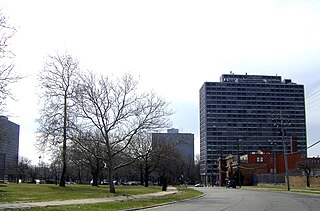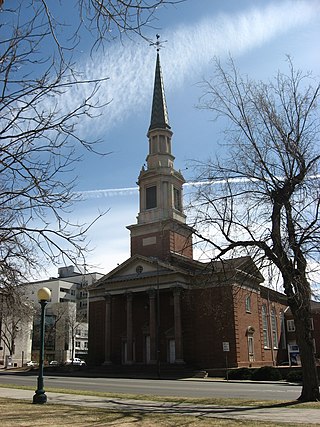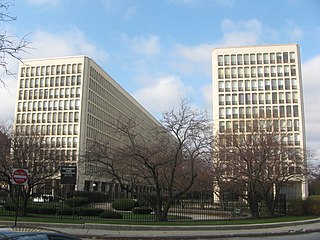
The Brown Palace Hotel, now The Brown Palace Hotel and Spa, Autograph Collection, is a historic hotel in Denver, Colorado, United States. It is listed on the National Register of Historic Places and is the second-longest operating hotel in Denver. It is one of the first atrium-style hotels ever built. It is now operated by HEI Hotels and Resorts, and joined Marriott's Autograph Collection Hotels in 2012. The hotel is located at 321 17th Street between 17th Street, Broadway and Tremont Place in downtown Denver behind the Republic Plaza. The main entrance door is on Tremont Place.

The Colorado State Capitol Building, located at 200 East Colfax Avenue in Denver, Colorado, United States, is the home of the Colorado General Assembly and the offices of the Governor of Colorado and Lieutenant Governor of Colorado.

Lafayette Park is an neighborhood located east of Downtown Detroit. It contains a residential area of some 4,900 people and covers 0.07 sq mi.

Jules Jacques Benois Benedict was one of the most prominent architects in Colorado history, whose works include a number of well-known landmarks and buildings listed on the National Register of Historic Places.

Cheesman Park is an urban park and neighborhood located in the City and County of Denver, Colorado, United States.

The Mountain States Telephone Building is a historic building located at 931 14th Street in Denver, Colorado. It was listed on the National Register of Historic Places on January 26, 2005.

Fisher & Fisher was an architectural firm based in Denver, Colorado named for partners William Ellsworth Fisher (1871–1937) and Arthur Addison Fisher (1878–1965).

William Ellsworth Fisher was an architect who founded the Denver, Colorado firm that became Fisher & Fisher.

First Baptist Church of Denver is an historic church at 230 E. 14th Avenue-1373 Grant Street in Denver, Colorado. First Baptist Church of Denver ("FBCD") was formally organized in 1864, six years after the city's founding.

The All Saints Episcopal Church in Denver, Colorado, later known as Chapel of Our Merciful Saviour, is a historic church at 2222 W. 32nd Avenue. It was built in 1890 and was added to the National Register of Historic Places in 1978.

St. Anthony's Roman Catholic Church is a historic church at 329 S. 3rd Street in Sterling, Colorado, United States. It was built in 1911 and was added to the National Register of Historic Places in 1982.

The University Apartments, also known as the University Park Condominiums, are a pair of ten-story towers in Chicago, Illinois designed by I. M. Pei and Araldo Cossutta. The project was part of a city initiative to revitalize residential development in Hyde Park just north of the University of Chicago. Within the Hyde Park neighborhood, they are colloquially known as "Monoxide Island."
Merrill H. Hoyt was a prominent American architect, business man and leader in the building design community of Denver, Colorado from 1910 to 1933.
Walter Rice, also known as Walter L. Rice (1866–1930), was an American architect, inventor, and engineer. He made a career as an architect in Denver, Colorado, particularly for the design of apartment buildings. Several of his buildings are designated National Register of Historic Places. He patented inventions for automobiles.

Eppich Apartments is an apartment building in Denver, Colorado. The American Craftsman building was designed by Walter Rice, a Denver architect and built by Louis F. Eppich, a Denver real-estate developer. The towers and parapets reflect a medieval influence. The second-floor balconies at the front of the house have oriental elements of design in the intricate frame with butterfly beams. There are also Spanish Colonial design elements in the corbeled pylon and terra-cotta drain pipe. It was built facing the view of the Rocky Mountains and the Colorado State Capitol building, which now also includes Denver's high-rise buildings. Eppich owned the building until 1953. It was listed on the National Register of Historic Places on January 5, 1984.
The Tilden School for Teaching Health operated from 1916 to 1931 as a private residential teaching institution and sanitarium that offered patients an alternative to the standard medical practices of the day. Located in Denver, Colorado, the school was established to teach and promote the medical theories of its founder, Dr. John Henry Tilden.

The Edgewater in Madison, Wisconsin is a hotel which opened in 1948. It was listed on the National Register of Historic Places in 1997 as part of the Mansion Hill Historic District.

Spokane and its neighborhoods contain a patchwork of architectural styles that give them a distinct identity and illustrate the changes throughout the city's history. Spokane has a rich architectural history for a western city of its size and much of it is a product of its circumstances at the turn of the 20th century when as a rapidly growing city, the Great Fire of 1889 destroyed 32 blocks of the city center which was quickly rebuilt in a more grand fashion by a community flush with money coming from regional mining districts. Many of the architects that found work in the city and building on the blank slate of the downtown commercial district became highly esteemed architects such as Kirtland Cutter, who has been credited with giving the city a distinctive character. In particular, the city has a high concentration of Romanesque Revival style institutional and commercial buildings and American Craftsman bungalow residences. The architecture of Spokane gained national recognition in industry publications in the early 20th century.

The Altamaha Apartments, at 1490 Lafayette St. in the Cheesman Park neighborhood of Denver, Colorado, was built in 1902. It was listed on the National Register of Historic Places in 2004. It was designed by architect George L. Bettcher in Italian Renaissance Revival style.



















